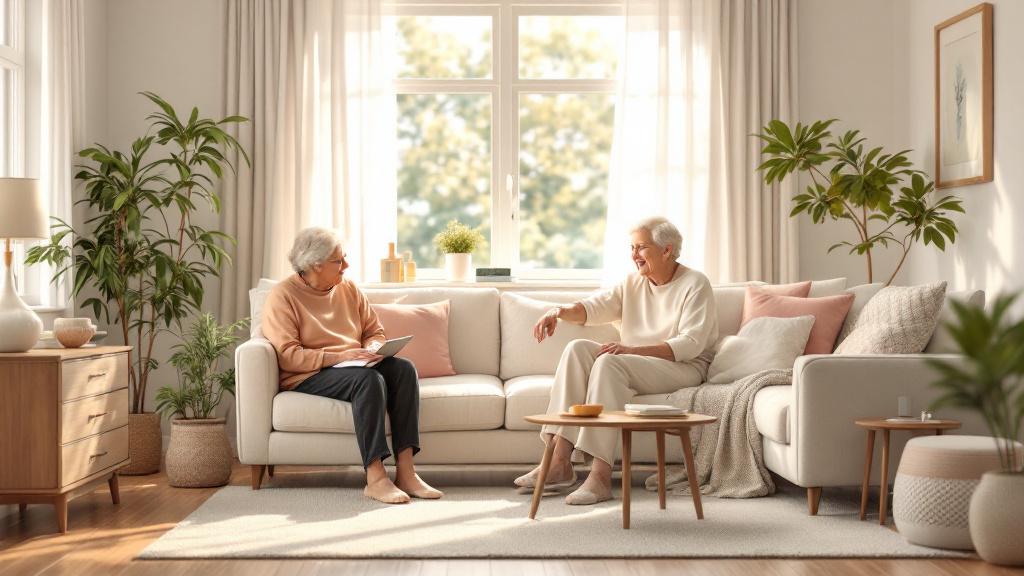The Role of Adaptive Equipment in In-Home Therapy
Enhancing Independence and Safety Through Adaptive Equipment

Unlocking Potential at Home
In-home therapy has become an increasingly vital component of fostering independence among individuals with disabilities, injuries, or age-related challenges. Central to this approach is the effective use of adaptive equipment, which encompasses a broad spectrum of devices and modifications designed to facilitate daily living activities, safety, and overall quality of life. This article explores the essential role adaptive equipment plays in in-home therapy, the types commonly used, and strategies for optimal integration.
Understanding the Scope of Adaptive Equipment in In-Home Therapy

What is the role of adaptive equipment in in-home therapy?
Adaptive equipment is vital in in-home therapy, helping individuals with disabilities, injuries, or aging challenges perform daily activities with greater independence and safety. These tools are tailored to meet specific needs, making everyday routines easier and more manageable.
Examples include mobility aids like walkers, wheelchairs, and stair lifts, which assist movement around the home. Bathroom safety devices such as grab bars, raised toilet seats, and shower chairs help prevent falls and facilitate hygiene tasks. Adaptive devices like reachers, sock aids, and dressing sticks support dressing and grooming, especially for those with limited reach or dexterity.
Occupational and physical therapists evaluate each person's situation to recommend appropriate equipment, ensuring it fits well and functions effectively. Properly chosen adaptive tools can significantly enhance a person’s ability to participate in daily activities, improve safety, and boost quality of life.
In-home therapy benefits from these devices by creating a safer environment and fostering independence. Whether it’s installing grab bars or providing customized utensils, adaptive equipment plays a crucial role in enabling individuals to live more comfortably and securely in their own homes.
Common Types of Adaptive Equipment and Home Modifications
What are the different types of adaptive equipment used in in-home therapy?
In-home therapy incorporates a broad range of adaptive equipment designed to support individuals in maintaining independence and ensuring safety within their living environments. One of the main categories is mobility aids, which include wheelchairs, scooters, walkers, canes, and crutches. These devices help individuals move around more freely, especially those with gait or balance issues.
Home modifications also play a vital role. Practical changes such as entry ramps, grab bars installed in bathrooms and hallways, stairlifts, and accessible bathroom fixtures make navigation easier and reduce fall risks. These modifications are tailored to meet individual mobility needs, creating a safer and more accommodating space.
For sensory, visual, and hearing impairments, specialized adaptive devices are essential. These include amplified telephones, assistive listening devices, screen readers, and white noise or sound masking systems for hearing impairments. Visual aids like magnifiers, talking clocks, and large-print materials help those with vision challenges perform daily tasks.
Collectively, these adaptive devices and modifications support individuals with various disabilities—mobility issues, sensory deficits, or cognitive impairments—in daily routines. Occupational therapists typically assess needs and recommend suitable tools and modifications, enhancing overall quality of life.
| Category | Examples | Purpose | Additional Details |
|---|---|---|---|
| Mobility Aids | Wheelchairs, walkers, canes, crutches | Enhance movement and balance | Available in manual or powered types |
| Home Modifications | Ramps, grab bars, stairlifts | Improve access and safety | Custom-fitted to individual needs |
| Sensory & Visual Devices | Screen readers, magnifiers, talking clocks, hearing aids | Support sensory processing | Designed for specific impairments |
| Communication Aids | Amplified phones, speech-generating devices | Facilitate communication | Used by those with speech or language difficulties |
These tools are often recommended after thorough assessment by healthcare professionals. Proper fitting, training, and ongoing support maximizes their benefits, making daily activities more manageable for individuals with disabilities.
Enhancing Safety, Mobility, and Independence at Home
 Adaptive equipment plays a crucial role in helping individuals lead more independent and safer lives within their homes. It includes a broad range of devices and modifications that cater to different needs, from mobility and sensory impairments to cognitive challenges.
Adaptive equipment plays a crucial role in helping individuals lead more independent and safer lives within their homes. It includes a broad range of devices and modifications that cater to different needs, from mobility and sensory impairments to cognitive challenges.
How does adaptive equipment improve independence, safety, and mobility at home?
Adaptive devices enable people to perform daily activities such as dressing, grooming, and cooking without constant assistance. For example, reachers, sock aids, and long-handled tools help with dressing and grooming, promoting autonomy. Safety is significantly enhanced through modifications like grab bars, stairlifts, and ramps, which reduce the risk of falls and injuries. For instance, bathroom grab bars and raised toilet seats make toileting safer, while stairlifts help navigate multiple levels securely.
Mobility at home is greatly improved with aids such as wheelchairs, walkers, and mobility scooters. These devices enable individuals with limited strength or balance issues to move freely, participate more actively, and access all areas of their home comfortably.
Sensory and cognitive aids also contribute to a safer environment. Hearing aids, visual magnifiers, and communication devices help those with sensory impairments better understand and interact with their surroundings, reducing confusion and risk.
The combined use of these adaptive tools creates a home environment that not only supports independence but also promotes confidence and well-being. Proper assessment, professional guidance, and suitable modifications ensure that users receive the most effective and appropriate solutions for their needs.
In summary, adaptive equipment fosters safer, more accessible surroundings that enable individuals with disabilities or limitations to live independently, participate fully in daily routines, and enjoy greater quality of life.
| Equipment Type | Examples | Benefits |
|---|---|---|
| Safety Modifications | Grab bars, stairlifts, ramps, widened doorways | Reduce falls, improve access, prevent injuries |
| Mobility Devices | Wheelchairs, walkers, mobility scooters | Facilitate movement, independence, participation |
| Sensory & Cognitive Aids | Hearing aids, visual magnifiers, communication devices | Enhance safety, understanding, interaction |
| Everyday Assistive Devices | Reachers, dressing sticks, adaptive kitchen tools | Support daily activities, foster autonomy |
Adaptive Equipment for Pediatric In-Home Therapy
What adaptive equipment is suitable for pediatric in-home therapy?
When supporting children with developmental or physical challenges at home, a variety of adaptive devices can significantly enhance their participation and safety. These tools are specifically designed to accommodate the unique needs of children, promoting independence and comfort in daily activities.
Pediatric mobility aids are essential for helping children move safely and effectively. These include items like specialized wheelchairs, strollers, walkers, gait trainers, and standing frames. These aids assist with balance, gait development, and overall mobility, encouraging active participation in routines.
Proper positioning is crucial for comfort and development. Adaptive seating devices such as therapy chairs, activity tables, and supportive benches promote correct posture and make participating in activities more accessible. They are adjustable to fit the child's size and needs.
Sensory input is often beneficial for children with sensory processing disorders. Sensory tools like swings, tactile toys, textured mats, and multi-sensory environments help children explore and regulate their sensory experiences in a safe manner.
Communication is vital for expression and social interaction. Augmentative and Alternative Communication (AAC) devices, switches, and communication boards support children who have difficulty speaking or communicating through traditional means, enabling them to express needs and participate fully.
Safety and caregiving tasks are simplified with appropriate equipment. This includes safety beds, bath aids such as non-slip mats and assistive bath seats, orthotic braces, and assistive orthoses that support proper alignment and movement. These tools help caregivers ensure safety, encourage independence, and facilitate routine care.
Implementing the right adaptive equipment involves assessing each child's specific needs, often with input from occupational and physical therapists. These professionals help select, customize, and train families in using these devices effectively.
| Equipment Type | Examples | Purpose |
|---|---|---|
| Mobility Aids | Pediatric wheelchairs, gait trainers, strollers | Support movement, balance, and gait development |
| Seating Devices | Therapy chairs, activity tables, supportive benches | Promote proper positioning and participation |
| Sensory Tools | Sensory swings, tactile toys, multi-sensory rooms | Address sensory processing and regulation |
| Communication Devices | AAC tools, switches, communication boards | Enhance expressive and receptive communication |
| Safety and Caregiving Tools | Safety beds, bath aids, braces, orthoses | Support safety, comfort, and routine tasks |
Choosing appropriate adaptive equipment relies on a thorough assessment of the child's needs and goals. Collaboration among healthcare providers, therapists, and family members ensures the selection of effective tools that foster growth and independence in the home environment.
Integrating Adaptive Equipment into Therapy Practices

How is adaptive equipment integrated into occupational and physical therapy practices?
Adaptive equipment is a vital part of occupational and physical therapy programs, tailored to help individuals improve their independence and safety in daily activities.
The process begins with a detailed assessment of the person’s needs, abilities, environment, and specific goals. Therapists analyze how the individual performs tasks and identify areas where adaptive devices could be beneficial.
Based on this evaluation, therapists recommend a variety of adaptive tools, such as mobility aids (wheelchairs, walkers, canes), dressing aids (button hooks, sock aids), feeding devices (weighted utensils, scoop plates), and environmental modifications (grab bars, ramps). These devices are chosen to align with the patient's unique requirements and to support their therapy objectives.
Customization is often necessary to ensure proper fit and functionality. Therapists may modify devices or select specific features to accommodate personal preferences and physical limitations.
Training plays a crucial role in therapy. Patients are taught how to safely and effectively use their adaptive equipment, with emphasis on correct positioning, operation, and maintenance. Proper training minimizes risks and maximizes benefits.
Therapists integrate the use of adaptive equipment throughout therapy sessions, gradually increasing complexity and independence. They also monitor progress and adjust equipment or strategies as needed.
Collaboration among healthcare professionals, patients, and caregivers ensures comprehensive support. Keeping up with technological advances and new devices helps therapists incorporate the most effective tools into treatment plans.
Overall, the thoughtful integration of adaptive equipment enhances mobility, self-care, communication, and overall participation in daily life activities.
Distinction Between Adaptive Equipment and Assistive Technology
What is the difference between adaptive equipment and assistive technology?
Adaptive equipment is a specific subset of assistive technology, targeted primarily at helping individuals with disabilities perform daily activities or move around more easily. While assistive technology encompasses a broad array of devices, both simple and advanced, that help users maintain or enhance their functioning—such as hearing aids, prosthetic limbs, or visual aids—adaptive equipment is often customized to address particular needs.
Assistive technology can include electronic systems, software, and devices designed to make tasks easier for a wide range of users, including those without disabilities. For example, screen readers or voice recognition software are considered assistive technology that can support individuals with visual or motor impairments.
On the other hand, adaptive equipment usually refers to physical tools or modifications tailored to specific tasks or environments. Examples include mobility aids like wheelchairs, grab bars, or stair lifts, which are often customized to fit the user’s body or living space.
Furthermore, the term 'assistive technology' frequently covers electronic and digital solutions, while 'adaptive equipment' is more focused on tangible, often mechanical devices. Despite these differences, both aim to promote independence, safety, and participation in daily life.
In summary, assistive technology includes a broad spectrum of devices and systems that support various functions across different contexts, while adaptive equipment is a specialized form of assistive technology, often customized, designed to meet specific needs related to mobility and activity performance.
Strategies for Selecting and Implementing Adaptive Equipment

What strategies should be used for selecting and using adaptive equipment to support recovery and rehabilitation at home?
Choosing and using adaptive equipment effectively begins with thorough assessment by qualified healthcare professionals, such as occupational therapists. These experts evaluate an individual's specific needs, limitations, and safety considerations to identify the most appropriate devices.
The selection process should focus on tailoring equipment to the person's functional abilities, preferences, and home environment. For example, mobility aids like walkers or wheelchairs, sensory devices, or communication tools should be chosen to match the individual's unique circumstances.
Proper training is essential to ensure safety and maximize the benefits of adaptive equipment. Patients and caregivers should learn correct usage, maintenance routines, and troubleshooting tips through hands-on instruction.
Regular reassessment is vital to adapt to changing needs or to adopt new technologies. Routine reviews can help identify if current equipment remains suitable or if modifications are necessary.
In addition to device selection, home modifications play a crucial role. Installing ramps, grab bars, accessible kitchen cabinets, and bathroom features like roll-in showers complement adaptive devices, creating a safer and more functional environment.
Implementing these strategies promotes independence, supports recovery, and enhances overall quality of life, making sure that both individual needs and safety are prioritized throughout the rehabilitation process.
Navigating the Process of Acquiring and Implementing Adaptive Equipment
What is the process for obtaining and implementing adaptive equipment for therapy needs?
The journey to acquire adaptive equipment begins with a thorough evaluation by healthcare specialists such as occupational therapists or physical therapists. These professionals assess the individual's specific impairments, daily routines, home environment, and safety considerations. This detailed assessment helps determine the most suitable adaptive tools or modifications to support independence.
After the assessment, the healthcare provider recommends customized or off-the-shelf equipment that best matches the individual's needs. This could include mobility aids like wheelchairs and walkers, communication devices, bathroom safety modifications, or adaptive kitchen tools.
Funding and procurement are crucial next steps. To secure financial support, individuals or their caregivers typically submit documentation demonstrating medical necessity to programs such as Medicaid, Medicare, private insurance, or assistive technology grants. Depending on coverage, equipment can be purchased outright, leased, or rented through authorized providers.
Once the adaptive equipment is acquired, professional fitting and installation ensure that devices like stair lifts, grab bars, or adapted seating are properly installed for safety and comfort. Training sessions provided by specialists teach individuals and caregivers how to use the devices correctly, promoting safety and maximizing independence.
Finally, ongoing oversight involves regular follow-ups and reassessments. As needs evolve or issues arise, adjustments or new equipment may be necessary. Proper maintenance, periodic evaluations, and updates ensure the continued effectiveness and safety of the adaptive aids, helping users maintain their functional abilities in daily life.
The Impact of Adaptive Equipment on Quality of Life at Home

How does adaptive equipment contribute to improved quality of life for individuals with disabilities or age-related challenges?
Adaptive equipment plays a vital role in enhancing the daily lives of people facing disabilities or aging-related difficulties. These devices help individuals perform routine activities such as mobility, self-care, and communication more independently and safely. For example, mobility aids like wheelchairs, walkers, and stair lifts enable easier movement around the home and reduce the risk of falls.
Using adaptive tools and environmental modifications, such as grab bars in the bathroom or ramps at entrances, not only increases safety but also encourages frequent social participation. This fosters a sense of autonomy, self-confidence, and dignity. These devices also support physical health by minimizing strain and preventing secondary health issues like pressure sores or joint pain.
Mental well-being improves as users regain independence and control over their daily routines. Moreover, adaptive equipment reduces dependency on caregivers, easing emotional and physical strain on families and support systems.
In terms of community involvement, adaptive tools enable older adults and individuals with disabilities to stay engaged in social activities, employment, and leisure pursuits. This participation enhances their overall sense of inclusion and purpose.
Overall, adaptive equipment significantly boosts quality of life by fostering independence, supporting health, reducing caregiver stress, and encouraging social participation. These benefits contribute to a more active, safe, and fulfilling lifestyle, ultimately improving overall well-being and life satisfaction.
| Aspect | Benefits | Examples |
|---|---|---|
| Fostering independence | Allows performing daily activities solo | Mobility aids, adaptive kitchen tools, dressing aids |
| Supporting health and safety | Prevents injuries and secondary issues | Grab bars, stair lifts, roll-in showers |
| Reducing caregiver burden | Less assistance needed from caregivers | Remote monitoring systems, accessible home modifications |
| Community participation | Enables social and recreational activities | Adaptive sport equipment, communication devices |
By integrating these devices into everyday life, individuals gain more control and confidence, enriching their overall quality of life.
Empowering Independent Living at Home
Adaptive equipment is a cornerstone of effective in-home therapy, offering individuals the tools they need to regain or maintain independence, ensure safety, and participate fully in daily life. When selected and used appropriately—guided by healthcare professionals—these devices and modifications not only facilitate functional routines but also enhance emotional well-being and social inclusion. As technology advances, the integration of innovative adaptive solutions continues to improve the quality of life for countless individuals, emphasizing the importance of accessible, tailored, and supportive home environments. Empowered by proper assessment, training, and ongoing support, individuals can achieve greater independence and enjoy a higher quality of life within their own homes.
References
- Assistive Equipment for the Home - Johns Hopkins Medicine
- Assistive Devices for People with Disabilities - UDS Foundation
- Revolutionizing Occupational Therapy with Adaptive Equipment
- What is adaptive equipment for Occupational Therapy? - Physio Inq
- [PDF] Adaptive Equipment and Energy Conservation Techniques During ...
- What is adaptive equipment, and how is it used in occupational ...
- Restoring Confidence and Independence with Adaptive Equipment ...
- Adaptive Equipment: What it is and How it Can Help Your Child

How to Plan for Long-Term Home Care Services

How Home Team Helps Families Make Informed Care Decisions

How Home Team's Caregivers Provide Peace of Mind for Families



